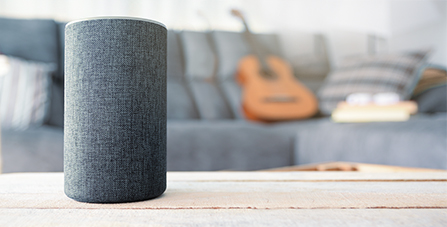Grow your business with the Discover newsletter
Logistics advice & insights straight to your inbox
Subscribe now

Machine learning may seem daunting, but it's getting more user-friendly for 2020. In fact, it’s not only a great way to free up time to work on other aspects of your business, but also to help retain and earn custom. Modern, sophisticated algorithms can find out your customers’ preferences on not only cost and brand, but color, gender, size, and plenty more factors that could make the difference between a sale and an abandoned cart.
Moving away from a manual system can make your business more efficient, and make your customers feel like you understand their likes and dislikes more accurately with every purchase. AI’s ability to analyze human habits means it can learn what is and isn’t working much faster than you can, and even fix issues that you weren’t aware of by recognizing common themes.
At its most simple level, AI in e-commerce is a useful tool for managing your product inventory, and alerting you when you need to restock. However, chatbots (and conversational marketing) are the real area of progress we’re looking forward to in 2020. Of course, e-commerce chatbots have existed for a while, but the levels of sophistication we’re seeing now far outstrip what’s been possible before. 67% of shoppers have used one in the last year (some without even knowing), and 40% of shoppers don’t care whether it’s a robot or human that helps them, as long as they get the assistance they need1. And, according to Grand View Research, 45% of people agree that chatbots are their primary choice for customer service inquiries2.
Of course, your company’s positioning will affect whether a chatbot is a good idea or not. If a big part of your service is the personal touch, your customers may be put off by one. However, if you’re growing quickly, and expanding your customer base, expectations will also need to be met – and a chatbot could help you respond to the questions that need answering, fast, as we discovered in our assessment on how live chat can boost your business.
One more thing to consider in this space is the adoption of dynamic pricing – and by that we mean giving your product the best chance of selling, while still making as much profit as possible. To do so, you'll need to stay on top of your competitors' pricing, as well as demand for the item, in order to deliver real-time updates that make your site the most appealing option for purchase – handy if you're selling items available elsewhere, or selling your own product against competitors with similar specifications.

One person’s trash is another person’s treasure. Or, one person's unwanted coat could be another’s fashion-forward discovery. The fact is, the resale market is growing exponentially. And we’re not just talking about eBay. We’re talking about stores growing 20-times faster than the broader retail market – and five-times faster than off-price retailers – according to Coresight Research. It’s big business - for instance, collaboration items have huge potential, where the value of items can increase by as much as 374% in the case of the Supreme x Louis Vuitton Danube Satchel on Vestiaire Collective.
Companies like Vestiare, thredUp, and The RealReal are taking advantage of the lucrative luxury fashion market, but luxury isn’t the only sector that’s making recommerce solutions a big deal. Sneaker resale, especially for resellers such as StockX, GOAT, and Stadium Goods, is growing all the time, and with the market predicted to hit US$6bn by 2025 it’s a case of the sooner the better if you want to take advantage.
In the UK, brands are even taking to buying back their old items, with both John Lewis and Adidas offering vouchers in return for old items, which will be repaired, resold, or broken down to create new items. And while there’s obvious benefit for both customer and manufacturer, there’s an obvious ecological benefit too – which leads us on to…

Regular readers of Discover will know that we’ve covered sustainability a lot in recent months – and with good reason. With growing awareness of the impact of existing products on the planet, new solutions are arriving all the time, and it’s no different in the logistics sphere.
Electric vehicles, packaging innovation, and not to mention the demand from younger generations to help protect the planet has led to an array of opportunities for business growth. By focusing on streamlining and cutting waste through the entire production and delivery process – and how extending the lifetime of products and materials to keep them in circulation – aligning your business with circular economy principles could be hugely beneficial.
Going green doesn’t happen overnight, but being able to shout about your business’ eco-friendly credentials could lead to more people clicking the buy button in 2020. Whether it’s the materials you source, how you receive them, how you package your product, or how you can present these factors to your customers, sustainability is going to be as big, if not bigger, than it was in 2019.

Ever quit a website because it wouldn’t load quickly enough? Of course you have, because in e-commerce, speed is everything. In fact, 53% of users will abandon a site if it takes longer than 3 seconds to load – and once loaded, users expect it to be fast.
That’s where the benefits of PWAs really come into their own. Because they can be added to a mobile's home screen, they’re always ready to go – so your products are never too far away. It’s something that AliExpress have managed to harness, seeing a 104% rise in new users, as well as an 84% increase in its iOS conversion rate since introducing the functionality.
Other companies are also using them to great effect, including India’s OLX, which increased its user re-engagement 250%, and Lancôme – who saw a 17% increase in conversions, a 53% increase in mobile sessions on iOS and an 8% increase in conversion rates on recovered carts, through the ability to use push notifications to prompt sales.

What’s improved cell phone signal got to do with e-commerce? Everything. Mobile shopping is on the rise. More and more people are connected to brands whilst on the move – and , with improved cell reception to do so from almost anywhere. So, the most crucial thing for your e-commerce store is to ensure you’re set up to sell on the smallest screen.
As we mentioned earlier, PWAs are the forward-facing choice, but that doesn’t mean you can ignore your website, or your app (if you have one). shopping is the fastest-growing activity on smartphones, thanks in no small part to the ease with which phones can store your payment details and streamline the purchase process. And given how long each day people spend on their phones, it’s no surprise what the next topic of conversation is…

With 55% of US consumers buying something online after discovering it on social media, tagging your products on Instagram, incorporating buyable pins on Pinterest and opening a Facebook shop could be key to your business booming in 2020.
China’s WeChat is showing the rest of the world how it’s done. In fact, Chinese users spend approximately one-third of all their time on mobile in WeChat, because they never have to leave the app. Platforms such as Instagram are making great strides in the sector, with the progression to Checkout making for a more streamlined process. How the other big players react this year is sure to make this one to watch – and how you capitalize on it could be the difference between a good year and a great one!

But why should customers pick up their phones when they can simply tell their smart speaker what it is they want? Yes, 2020 is set to be the year of voice-activated shopping.
As consumers have become increasingly open to the idea of integrating smart technology into their households, smart speaker sales revenue has gone through the roof. Growing from around US$900m in 2016 to nearly US$12bn in 2019, it’s estimated it could reach US$35.5bn by 2025. And the more smart speakers there are, the more chances there are for you to make a sale – becoming part of the predicted US$40bn category sales in 2022.
Sound good? Well, here’s how you can take advantage. You’re going to need to optimize your site for voice search – which is very different to being optimized for typed searches. Knowing what your customers are after, and how they ask for it, is going to be key for you over the coming months. But once you’ve mastered it, you should notice the difference it makes.

Getting your brand in hands can make a monumental difference. For people who are on the fence about purchasing, it can make their minds up. For people who have never heard of you, it’s a chance to get to know and understand your products. And, for you, it’s a chance to show the world that you mean business.
Going from e-commerce to physical stores can be daunting, but it’s an opportunity to show off the very essence of your being, and to talk face-to-face with the people you’re looking to attract. Because customers no longer need to visit stores to make their purchases, this is your chance to really let them experience what makes your products great. By making it memorable – whether it’s the visual aspects, how people get to grips with your items, or how you sell your story – you stand a much better chance of making sales, finding new fans, and becoming an altogether more compelling choice.
UK-based razor brand Harry's made the move in 2019, acquiring space in 300 pharmacies – and have seemingly fought off the challenge of subscription-based services such as Dollar Shave Club. So what are you waiting for? Get out there and sell!

Finally, we'll draw your attention to headless e-commerce solutions, which consciously remove your website's presentation layer from its backend e-commerce functionality, offering you (and your customers) a more flexible, seamless digital experience. It means that front-end developers can focus on creating the best possible user experience, ensuring it fits nicely with the core needs of the business, and don't need to spend time worrying about modifying databases in the backend – as all they need to do is make a simple API (Application Programming Interface) call.
Platforms such as Magento 2, Shopify Plus and Core dna have allowed many e-retailers to take advantage of this already, allowing them to remain competitive, and agile, within their own selling sphere. And, because APIs are prepared to communicate with any new device or channel that emerges in 2020 and beyond, your content will remain future-proof, no matter what innovative device next hits the market. If you're contemplating headless e-commerce this year, there's plenty of info out there on the pros and cons, but we believe this is the year it really comes to the fore.